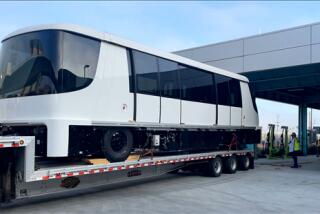Trolley buff guides others down the tracks of memory
Once there was a little boy who rode Henry Huntington’s trolleys.
He was 4 when he first took a Yellow Car all by himself, along Vermont Avenue to nursery school. His mother handed him off to the motorman and said he was going to the end of the line.
Now that little boy is 88, his mother and the trolleys long gone.
PHOTOS: Los Angeles’ Pacific Electric Red Cars
So is his grandfather’s Rialto orange grove, where he was sent to help weed come summer. So are the horse-drawn wagons that used to deliver his morning milk.
He’s standing at a lectern at the San Marino public library, clicking through black-and-white images on a screen.
Here’s a wooden Red Car trolley. Here are ladies, dressed to the nines, boarding a streetcar to shop downtown department stores.
Here’s the wide-open countryside that Red Car riders once viewed as they passed rural Compton on the way to Long Beach.
Once there was a little boy who rode Henry Huntington’s trolleys. Now that fact alone is enough to draw a crowd to hear him speak.
Even today, people want to hear about the trolleys, especially the Red Cars — how at their peak, they crisscrossed four counties on more than 1,000 miles of track, why they disappeared, what L.A. would be like if they were still running today.
It’s 7 p.m. on a weeknight, and every seat in the large room at the Crowell Public Library is taken. More than 20 people stand, leaning against the walls. And because maximum capacity has been reached, a dozen or so sit in the foyer outside, watching and listening to the speaker through the open door.
His name is Jeff Arnett. He’s a retired financial executive, an enthusiastic historian and a longtime railway buff. He tells them all about how Huntington bought up land and grew his trolley system to take people to it.
He brings back to life a long-ago Los Angeles, when his father worked at Bullocks, where children learned manners in the tea room on Wilshire. In a city still being built, the sound of the streetcars carried, and from his bed he could hear them rumbling through the night.
On his solo trolley rides, he practiced reading, he says.
“On the streetcar was a sign I paid no attention to. It said, ‘Unnecessary conversation with the motorman is prohibited.’ And there was another one — a holdover from a little rougher era — that said, ‘Do not expectorate on the floor.’”
“I always used to wonder what that meant,” one woman replies out loud, because in this crowd there is much murmured call and response. Many who have come are of a certain age. Quite a few rode the Red Cars (which Southern Pacific took over in 1911) before the last remaining line shut down 52 years ago.
Bette Cook, 71, remembers coming into Los Angeles from San Bernardino for Madame Frey’s ballet class — and how riding the trolleys felt like “a big-city thing to do.” Joan Redford, 80, says she used to take the Red Car over the Cahuenga Pass from North Hollywood to Hollywood, to skate at the Polar Palace ice rink.
With Arnett as guide, they go back in time, to Red Car rides to the Catalina Steamer on the way to summer camp, to family holidays at Balboa when “father, if he spent the weekend with you, could catch the 7 o’clock train on Monday morning and be at 6th and Main by 8:20.”
Eventually, Arnett gets to the bit about trolleys fading out and buses rolling in and freeways being built. There are those in the crowd who want to hear him talk conspiracy or blame power brokers.
In this, he disappoints.
“By the late ‘30s, many riders were turning to their cars for transportation — my family among them — and our increasing flood of cars was slowing down these interurbans as we crossed their paths and jammed them up on the street,” he says.
“Were they much different than the disappearance of manual typewriters? Or how about those 50-pound Friden calculators we used to carry from one desk to another? Or those smelly 7-foot-tall copy machines in the hallway? Or glass milk bottles?”
People smile. Heads nod.
What’s gone is gone, but the tracks remain in their memories.
Lelyveld writes the City Beat column. Follow City Beat @latimescitybeat on Twitter and at Los Angeles Times City Beat on Facebook.
More to Read
Sign up for Essential California
The most important California stories and recommendations in your inbox every morning.
You may occasionally receive promotional content from the Los Angeles Times.











